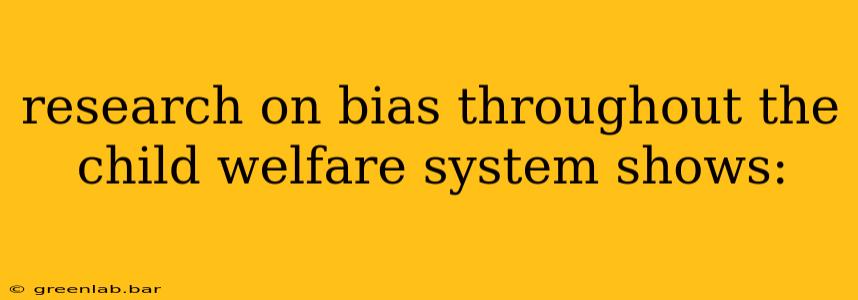Research on Bias Throughout the Child Welfare System Shows Systemic Inequities
Research consistently reveals that bias significantly impacts the child welfare system, leading to disproportionate involvement and negative outcomes for children and families from marginalized communities. This isn't simply about individual prejudices; it's a systemic issue embedded in policies, practices, and perceptions. This deeply ingrained bias manifests in various ways, impacting everything from initial reports to reunification processes.
Types of Bias in the Child Welfare System
Several types of bias contribute to these inequities:
-
Racial Bias: This is perhaps the most widely documented form of bias. Studies consistently show that children of color, particularly Black and Indigenous children, are overrepresented in the child welfare system compared to their proportion in the general population. This isn't necessarily due to higher rates of child maltreatment, but rather to factors like implicit bias among caseworkers, differing cultural understandings of parenting, and socioeconomic disparities that often lead to false or exaggerated reports.
-
Socioeconomic Bias: Poverty significantly increases the likelihood of child welfare involvement. Families struggling financially may face more scrutiny, even if their parenting practices are comparable to wealthier families. Limited resources, housing instability, and lack of access to support services contribute to this disparity. The system may inadvertently penalize poverty rather than addressing the underlying causes.
-
Implicit Bias: This refers to unconscious attitudes or stereotypes that affect our understanding, actions, and decisions. Caseworkers, despite good intentions, can be influenced by implicit biases, leading to quicker judgments or harsher interventions for families from marginalized groups. This bias operates on a subconscious level, making it difficult to identify and address.
-
Cultural Bias: Differences in cultural practices and parenting styles can be misinterpreted as neglect or abuse. What may be considered normal parenting in one culture might be viewed negatively in another, leading to unnecessary interventions. Lack of cultural sensitivity within the system exacerbates this issue.
Manifestations of Bias Throughout the System
The impact of bias isn't limited to a single stage of the child welfare process. It manifests throughout:
-
Reporting Stage: Reports alleging child maltreatment are more likely to be filed against families from marginalized communities, often based on biased assumptions or misunderstandings.
-
Investigation Stage: Investigations involving families from marginalized communities may be more thorough and intrusive, leading to disproportionate removal of children from their homes.
-
Case Management Stage: Caseworkers' implicit biases can influence their interactions with families, impacting the support and services offered. Families facing systemic barriers may receive less effective support, leading to prolonged involvement in the system.
-
Court Proceedings Stage: Bias can influence judicial decisions, resulting in harsher outcomes for children and families from marginalized groups.
Addressing Bias in the Child Welfare System
Tackling bias requires a multifaceted approach:
-
Increased cultural competency training: Training programs focusing on implicit bias, cultural sensitivity, and trauma-informed care are crucial for caseworkers and all child welfare professionals.
-
Data collection and analysis: Collecting and analyzing disaggregated data can help identify disparities and track the effectiveness of interventions.
-
Community-based solutions: Partnering with community organizations and engaging families in decision-making can create more culturally responsive and equitable services.
-
Policy reforms: Policy changes are necessary to address systemic inequities and promote racial and socioeconomic justice within the system.
Addressing the pervasive bias in the child welfare system requires a sustained commitment to systemic change. It necessitates a deeper understanding of the intersecting factors of race, class, and culture and their impact on families' interactions with the system. Only through a concerted effort to implement evidence-based strategies can we work towards a more equitable and just child welfare system.

